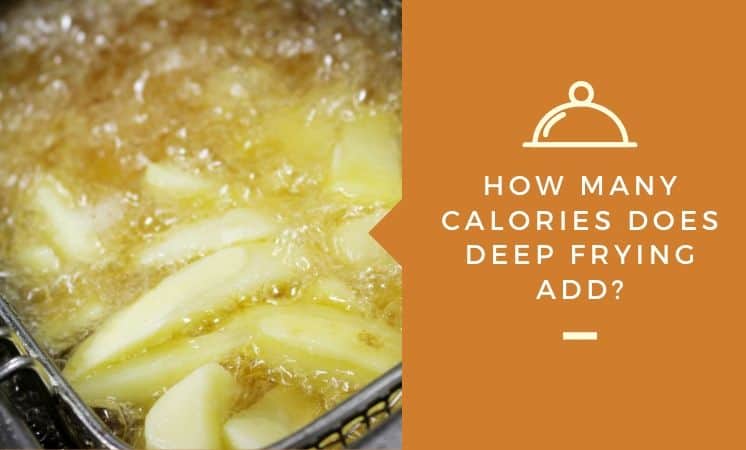When it comes to fried foods, we have a dilemma. We love French fries or fried chicken, but we know it’s not healthy. So what should we do? Skip the French fries and ignore the calories, or think about the calories and eat in moderation? Unless we know how many calories frying food adds, we don’t know what moderate amount is.
How many calories does deep frying add? While deep frying makes the food taste good, it also adds a serious amount of calories and fat to the food. And eating fried foods in large amounts can lead to many health conditions and diseases. In addition to this, these foods are high in trans fats that are linked to many health conditions.
Most people know that the overconsumption of fried foods is unhealthy. We’ll explain how fried foods add calories and how many, so you can decide what a moderate amount is for you.
What is Deep Frying?
Deep frying is a cooking process during which food is submerged in hot cooking oil at temperatures between 350°F and 375°F. When you submerge your food in the oil, its surface cooks immediately and develops a barrier that prevents the oil from penetrating.
The moisture present inside your food converts into steam and cooks your food from the inside. The steam also prevents oil from entering the food. That is why if you deep fry your food at a low temperature, the oil will seep into the food and make it greasy.
On the other hand, if you deep fry at a very high temperature, your food can dry out, and the oil can get oxidized.
Foods absorb fat and lose water when they are deep-fried in oil. This adds plenty of calories. And according to a study, 75% of the calories in these foods come from fat. That is why fried foods contain more calories and fat than non-fried foods.
Here’s an example:
- 100g of baked cod (fillet) provides you with 0.8g of fat and 105 calories.
- 100g of deep-fried fish gives you 12g of fat and 232 calories.
Check out this second example:
- 100g of small baked potato contains 0g of fat and about 93 calories.
- 100g of French fries has 17g of fat and 319 calories.
The fried fish is a little over twice as many calories as the baked. The French fries have over three times as many calories as the baked potato!
And what about the oils used in deep-frying?
Calorie counts in deep-frying oils include:
| One tablespoon of peanut oil | 119 |
| One tablespoon of corn oil | 122 |
| One tablespoon of soybean oil | 120 |
| One tablespoon of canola oil | 124 |
Bottom Line: The process of deep-frying can add a huge amount of calories to your daily intake, depending on the amount of food you eat and the type of food you deep-fry.
The healthier alternative to deep-frying food is, of course, the air fryer. While the taste and texture produced by the air fryer isn’t an exact replica of the deep fryer, it can still achieve awesome results.
Should You Be Concerned Only About Calories?

Know that calories are not the only things you should worry about when it comes to deep-fried foods.
Fried Foods Are High in Trans Fats
Trans fats are formed through an industrial process called hydrogenation. Fats are hydrogenated using hydrogen gas and high pressure to raise their shelf life. However, hydrogenation takes place when cooking oils are heated to high temperatures.
As a matter of fact, trans fats have been found to be linked with diseases such as obesity, diabetes, cancer, and heart disease.
To sum it up, you should avoid foods containing trans fats as much as you can.
Fried Foods Increases Your Risk of Disease
Eating fried foods can increase your risk of many diseases. Many studies have found a relationship between consuming deep-fried foods and the risk of chronic disease. Here are a few of their findings.
Consuming fried foods increases your risk of developing obesity, heart disease, and type 2 diabetes.
Eating fried foods may also increase your blood pressure and decrease your high-density lipoprotein (HDL) cholesterol. HDL cholesterol is good cholesterol that may benefit your heart.
According to a study, subjects had a 48% higher risk of heart failure if they consumed one or more servings of fried fish every week.
Research has also shown that consuming foods that are deep-fried elevates your risk of developing type 2 diabetes.
According to one study, individuals who ate fast food two times every week were more vulnerable to developing insulin resistance than their counterparts who consumed fast food less than once every week.
Studies found that fried foods contain trans fats that can play a part in obesity. As a matter of fact, these not-so-good fats can affect the hormones that modulate fat storage and appetite.
Deep Frying in Healthy Oils
The good news is that you can cook fried foods at home using healthier oils. There are many healthy options to try. It’s worth knowing that some cooking oils are safe to use because they can withstand much greater temperatures than other cooking oils.
You can use sunflower oil and extra light olive oil to fry your foods. Why? Because they contain good unsaturated fats and have high smoke points. Apart from these oils, you can also use peanut, safflower, and canola oils.
What is the smoke point?
The smoke point is the temperature at which your cooking oil starts to burn, producing dangerous compounds. By choosing a cooking oil that has a high smoke point, you can deep fry your foods at a higher temperature without any worries. Let’s have a look at the smoke point of some of the oils.
- Peanut oil: 450°F
- Canola oil: 435°F
- Olive oil: 410°F
These cooking oils are valuable sources of unsaturated fats that are considered good for your health. In fact, monounsaturated and polyunsaturated fatty acids may help maintain healthy cholesterol levels.
A Few Things to Remember When Eating Deep-Fried Food
It’s important to keep in mind that cooking oils form trans fats if you use them again and again or keep them at higher temperatures for a long period of time. That’s why it would be better if you avoid commercially deep-fried foods because the frying oil is reused several times.
Reserve fried foods for special occasions, like holidays or birthdays.
When possible, fry the food yourself so that you’ll know the type of oil used as well as the rest of the frying process.
It can be hard to completely avoid fried foods, so don’t beat yourself up if you decide to eat something fried.
Switch from fried foods to their baked or grilled versions. When cooked correctly, chicken can be just as delicious when it’s baked or grilled as when it’s fried.
Consuming fried foods in moderation is easy enough since you can still enjoy your favorite foods. If you want to use a deep fryer at home, that’s a much better option than ordering fried food from a restaurant.
You’ll have more control over the oil you use, and you can start with new oil for each batch of food. This can be especially helpful when you have an allergy, say to peanuts or peanut oil.’
Cooking in a Healthy Way Is the Key
You need calories to live. However, consuming too many calories is detrimental to your health. Deep frying adds significant calories to your food.
Luckily, deep frying foods at home allows you to choose the type and amount of oil you use, so you can avoid consuming more calories than necessary.
Fried foods are not only high in calories, but they are also high in harmful trans fats. Moreover, consuming these foods may also raise your risk of many diseases. Fortunately, there are many healthier oils that you can use to deep fry your food.
So you don’t have to give up your French fries—just don’t eat them every day.

